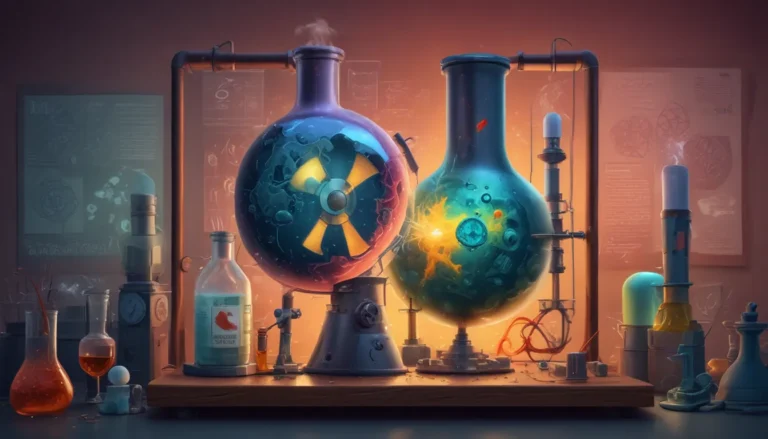A Note About Images: The images used in our articles are for illustration purposes only and may not exactly match the content. They are meant to engage readers, but the text should be relied upon for accurate information.
The Arrhenius Equation, a pivotal concept in chemistry, elucidates the temperature dependency of reaction rates. Crafted by the ingenious Swedish scientist Svante Arrhenius in 1889, this equation holds immense significance across various domains of chemistry, encompassing chemical kinetics, thermodynamics, and materials science. By delineating a mathematical correlation between the rate constant of a reaction and the temperature at which it transpires, the Arrhenius Equation lays the groundwork for predicting and regulating chemical reaction rates, thereby playing a pivotal role in industries ranging from pharmaceuticals to energy production.
Key Takeaways:
- The Arrhenius Equation, crafted by a Swedish chemist, unveils the impact of temperature on the pace of chemical reactions. It acts as a specialized mathematical formula for envisioning reaction rates under varying thermal conditions.
- This equation stands as a cornerstone in chemistry and auxiliary fields such as pharmaceutical manufacturing and material design, aiding scientists in determining optimal reaction circumstances and unraveling the temperature-induced transformations.
The Fundamental Role of Arrhenius Equation in Chemical Kinetics
Devised by the erudite Swedish chemist Svante Arrhenius in 1889, the Arrhenius Equation serves as a fundamental tool in the realm of chemical kinetics, elucidating the interplay between temperature and reaction rates.
Unveiling the Math Behind the Equation
The Arrhenius Equation establishes a mathematical linkage between the rate constant (k) of a reaction, the temperature (T), and the activation energy (Ea). It is delineated as:
k = Ae^(-Ea/RT)
Here, k signifies the rate constant, A denotes the pre-exponential factor, Ea represents the activation energy, R stands for the gas constant, and T symbolizes the temperature in Kelvin.
Deciphering the Temperature-Driven Reaction Rate Variation
The Arrhenius Equation offers a quantitative rationale for the ubiquitous observation that the rate of a chemical reaction escalates with an increase in temperature. As the temperature surges, the exponential element in the equation amplifies, culminating in a higher rate constant and consequently hastening the reaction rate.
Broad Applicability of Arrhenius Equation
The versatility of the Arrhenius Equation transcends diverse chemical reactions, encompassing both homogeneous and heterogeneous processes. Particularly invaluable in comprehending and prognosticating the dynamics of reactions in industrial contexts, this equation serves as a linchpin in optimizing operational efficiencies.
Fundamental Assumptions Underpinning the Equation
Fundamentally rooted in a simplistic collision model, the Arrhenius Equation posits that the reaction rate is contingent on the collision frequency between the reactant molecules. Within this model, only a fraction of collisions possess the requisite activation energy to foster a reaction.
Bearing Limitations in Mind
While the Arrhenius Equation is a widely embraced framework in chemical kinetics, it harbors limitations. It postulates a steady activation energy throughout the reaction, disregarding intricate reaction mechanisms or intermediary steps. Moreover, it may not hold sway over reactions unfolding under extreme conditions.
Unraveling Activation Energies
By gauging the rate constants of a reaction at varying temperatures, one can rearrange the Arrhenius Equation to pinpoint the activation energy of the reaction. This intel proves pivotal in unraveling the reaction mechanism and configuring optimal reaction conditions.
Widespread Utility Across Diverse Chemistry Arenas
The omnipresence of the Arrhenius Equation extends to an array of chemistry spheres, spanning chemical engineering, pharmaceuticals, materials science, and environmental studies. It orchestrates a pivotal role in modeling and fine-tuning chemical reactions, and illuminating temperature-mediated processes.
In Conclusion
The seminal significance of the Arrhenius Equation in chemistry lies in its transformative impact on our comprehension of reaction kinetics. By integrating temperature as a pivotal variable, this equation furnishes invaluable insights into chemical reaction dynamics. Armed with a deeper understanding of the Arrhenius Equation, scientists and scholars can anticipate and regulate reaction rates, facilitating the genesis of novel materials, drugs, and industrial protocols.
Embarking on a quest to uncover the eight captivating facts about the Arrhenius Equation, we have unveiled its profound implications and extensive applications. From decoding the temperature-driven reaction rate alterations to its involvement in climate science and simulation, the Arrhenius Equation continues to sculpt our insights into chemical kinetics. The next time you encounter this equation in your scholarly pursuits or explorations, reminisce about its transformative influence and the myriad possibilities it harbors.
FAQs
-
What is the Arrhenius Equation?
The Arrhenius Equation is a mathematical formula that delineates the correlation between the rate constant of a chemical reaction and temperature, aiding in predicting changes in reaction rates with varying temperatures. -
Who is credited with discovering the Arrhenius Equation?
The Arrhenius Equation bears the name of Svante Arrhenius, a distinguished Swedish scientist who unveiled this equation in the late 19th century. -
What are the pivotal components of the Arrhenius Equation?
The Arrhenius Equation encompasses key components such as the rate constant (k), the pre-exponential factor (A), the activation energy (Ea), the gas constant (R), and the absolute temperature (T). -
How does the Arrhenius Equation facilitate reaction rate predictions?
By measuring the rate constant across diverse temperatures, the Arrhenius Equation enables the determination of activation energy and the forecast of reaction rate alterations with temperature fluctuations. -
What practical realms benefit from the Arrhenius Equation?
The Arrhenius Equation finds applications across myriad domains, including chemistry, materials science, pharmacology, and industrial operations. It proves instrumental in optimizing reaction conditions, comprehending thermal degradation, and crafting temperature-responsive models. -
How does the Arrhenius Equation intersect with climate science?
The Arrhenius Equation assumes relevance in climate science by elucidating the interplay between temperature and chemical reaction rates, unraveling processes integral to climate transformation like the greenhouse gas effect. -
Can the Arrhenius Equation be universally applied to all chemical reactions?
While the Arrhenius Equation serves as a potent tool for numerous chemical reactions, certain reactions may veer off course from its assumptions, necessitating alternative models or approaches. -
What strides has the Arrhenius Equation made in advancing our comprehension of chemical kinetics?
The Arrhenius Equation has fostered profound insights into the temperature-driven modulations of reaction rates, facilitating the formulation of precise models for prognosticating and managing chemical reactions. It has enriched our understandings of reaction mechanisms, enzyme kinetics, and the thermal stability of diverse compounds.
Unraveling the enigmatic realms of chemical reactions, the Arrhenius Equation assumes a pivotal role in unveiling the nuances of chemical kinetics. Temperature’s profound sway on reaction rates emerges as a focal point through this empowering tool, extending its utility from seminal discoveries to activation energy determinations, thereby becoming an indispensable facet of the diverse tapestry of chemistry.






